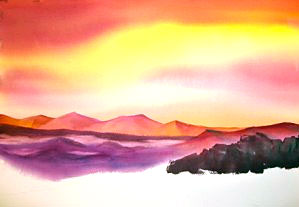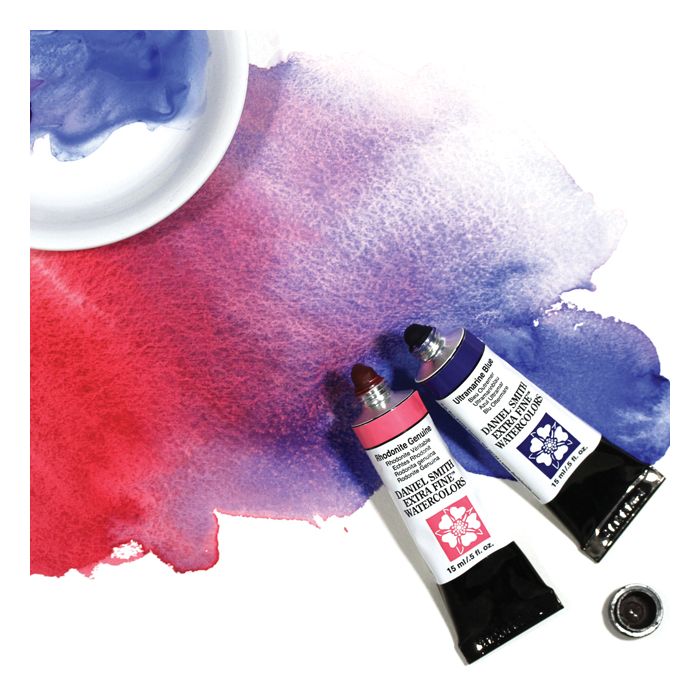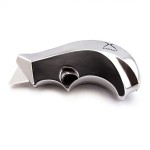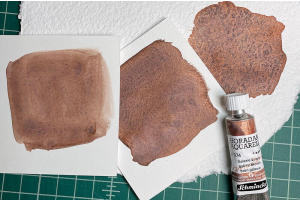We use cookies to make your experience better. To comply with the new e-Privacy directive, we need to ask for your consent to set the cookies. Learn more.
Cheap Joe’s Art Stuff Art Blog
Tips, Tricks, Thoughts, and inspiration from across the art spectrum.
Art Supplies For Every Studio Size

Whether you have a dedicated room for an art studio or your bedroom doubles as your workspace, there are steps you can take to create a convenient location to spread out your supplies and get inspired to create. Even if you have a really small area that you’re working with, there are plenty of art studio supplies you can purchase that don’t take up that much space. After all, the most common art supplies don’t tend to change based on studio size; most artists use the same general supplies to start with. So if you’re wanting to upgrade your home art studio, check out our list of the 20 most common small studio supplies.

1. Palettes and Paint Scrapers
We’re starting with the basics here and talking about paint palettes! Every artist needs a place to mix their paint colors, and that’s exactly what paint palettes are for. Paint palettes can be made of a variety of materials, but we find that glass palettes tend to be the easiest to clean off after being used, especially if you’re using acrylic or oil paints. All you have to do is use a razor paint scraper to scrape the paint off, and then wipe the excess off with a paper towel. It’s super easy, and it significantly cuts down your clean-up time! However, if you prefer to use watercolor paint, ceramic or plastic palettes tend to work best.

2. Paint
The typical artist will have at least some kind of paint in their studio. If you’re a new artist and you’re not sure what your paint preference is, try testing out some of the different kinds. Some of the more common paint options include acrylic, oil, watercolor, gouache, and encaustic. Ultimately, the paint you use just depends on what kind of product you’re wanting to create. We recommend the American Journey Artist’s Acrylic Paint if you’re wanting acrylic, or the Daniel Smith Extra Fine Watercolors if you want unique, pigmented watercolor paint.

3. Pencils
Another common art tool you’ll find in studios is pencils. There are tons of different kinds of pencils: sketching pencils, colored pencils, watercolor pencils, carpenter pencils, etc. Our Faber-Castell Polychromos Colored Pencil Sets are a great, affordable choice for any studio space. Don’t forget to get yourself one or two pencil sharpeners as well!

4. Brushes
You’ll always find a variety of brushes in an artist’s studio. There are many brush options out there, and you’ll most likely go through some trial and error before you find your favorite ones. The good thing about brushes is that they can last for many years if you take care of them properly. You’ll want to clean them thoroughly each time and re-shape them before you put them away. This will allow you to build up a collection of reliable brushes for your studio. If you’re just starting your brush collection, we always recommend Miller’s Pseudo Squirrel Brushes. They’re a fan favorite, and they’ll last you quite a while!

5. Erasers
Every artist needs a selection of erasers in their studio. Erasers do more than just fix our mistakes; they can also help lift excess graphite, store straight pins or blades, remove masking fluid, and even be cut into shapes to be used for other projects. These tools are relatively cheap, so you can definitely grab a few for your collection!

6. Utility Knives
You might not think you’ll need a knife when you’re painting, but having one on hand can be really useful! After all, utility knives can be used for more than just cutting. For example, you can use them for things like scraping dried acrylic paint off of a glass palette. They can also be used to apply texture to a watercolor painting. If you’re someone who repeatedly paints the same images or designs, you might consider using one of these knives for cutting out stencils to save time. Just remember to store these tools in a safe place to avoid any accidents!

7. Easels
One of the larger items you’ll want to have for your art studio is some kind of easel. There are tons of options out there to choose from, depending on your needs and budget. If you have a larger space, you could invest in a couple of different sizes of easels. There are also options like the American Journey Field Series Sketchbook Easel that take up less room if you’re working with a smaller studio space. These are great for tabletop use, small studios, and Plein air painting.

8. Canvas / Panels
All artists need a surface to paint on. The most common painting surface you’ll find in a studio is either stretched canvas or a panel that has canvas adhered to it. You can test out different canvas brands and decide which ones you like the best. Our Joe Miller Signature Series Stretched Cotton Canvas is one of our favorites and is professionally designed for use with acrylic or oil paints.

9. Large Work Surface or Table
If you have a super small studio space, you might not have room for a full-sized drafting table, and that’s okay. You can always repurpose other items that you have around the house! Kitchen tables often make great work surfaces, and you can easily place your tabletop easel on them. You might have to get a bit creative, but as long as you have a flat surface to work on, you’ll be fine.

10. Paper Towels or Rags
We bet you’re surprised to paper towels on our list of the most common art studio supplies! They aren’t something you typically think of as an art supply, but we’ve found that they’re very important. After all, if you’re an artist, you’re going to make a mess at some point. It’s inevitable! If you’ve used paper towels before, then you know that not all brands make products of the same quality. We recommend Viva paper towels because they’re super absorbent and can be reused if you give them time to dry between uses. Rags are also a great reusable option!

11. Color Wheel / Value Scale
Color wheels are a great addition to your small studio supplies list. They’ll give you something to reference when you’re choosing colors for your painting, and they’ll also provide you with value comparisons. There are even travel-sized color wheels, which are portable and great for smaller studio spaces. Overall, they’re a great source of information for any artist.

12. Painting Clothes
All artists know the struggle of trying to keep their clothes paint-free. That’s why we recommend you keep a stash of designated painting clothes in your studio. Aprons and smocks are good options to keep as painting clothes, but an old t-shirt that already has paint on it will do just fine.

13. Paper / Sketch Pads
It’s always a good idea to keep a collection of notebooks, pads of paper, sketchbooks, and regular sheets of paper around your studio. You never know when an idea will come to you, and you don’t want to find yourself searching for a notebook to write it down in. Plus, having more than one type of paper gives you some variety to work with when you start creating.

14. Swivel Chairs
We’ve found that stationary chairs aren’t the most comfortable or the most useful for art studios. Many artists prefer the movement that swivel chairs allow them, which is why they’re so commonly found in studios. The Studio Designs Mode Chair is extremely mobile and features a contouring design, so you’ll enjoy optimal comfort the entire time you’re working!

15. Daylight Lamps
Next on the list is a good daylight lamp. It’s nearly impossible to regulate the lighting in a studio, due to the many factors that can influence it and cause it to fluctuate. Because having proper lighting is super important for any artist, you’ll find daylight lamps in many studios. These lamps will help provide you with consistent lighting so you can continue to make the right value and color choices, regardless of outside variables (like the weather). Plus, you can continue painting even after the sun sets for the evening.

16. Cameras
Most people have said goodbye to their digital cameras and instead just use the ones that come on their smartphones. While newer smartphones do have pretty high-quality cameras, many artists still use digital cameras for photographing their work, so they’re a common find in art studios. If you can, it’s a good idea to invest in a nice camera. That way, you can get the best photos of your art to use when you’re wanting to make a portfolio or website.

17. Electronics (Computers, Printers, iPads)
Since digital products are becoming more prominent in the art world, it’s common for artists to have some kind of electronic device in their studio. Those who create digital artwork often have computers, laptops, or iPads, on which they can utilize various software and apps to create their pieces. It’s also common for digital artists to have printers so they can turn their designs into physical pieces of artwork. There are so many opportunities when it comes to digital products!

18. Instructional Materials (Books, Videos, Magazines)
If you’re an artist, then you know that your work is ultimately a result of the combination of influences you’ve encountered over the years. At this point, there aren’t that many brand new ideas to come up with anymore. Modern artists are instead tasked with the difficulty of reinventing old ideas to create fresh trends and techniques. That’s why you’ll often find stacks of instructional materials in an artist’s studio. Instructional art books and magazines can help artists improve their craft, while other materials track current trends in design and technique.

19. Portfolio
Portfolios have many purposes. They’re great for storing unfinished pieces, as well as transporting artwork. They also tend to be rather slim, so they’re able to be stored easily when they’re not being used. The Cheap Joe’s Artists’ Portfolio, 24” x 36” x 3” is a sleek and durable choice for protecting your art. If you’re just planning on using a portfolio for storage purposes, you can opt for a cheaper option. But if you’re going to be presenting your artwork, you might want to invest in a more professional-looking portfolio.

20. Storage
Being organized is key when it comes to maintaining order in a studio, especially when you’re working in a small space to begin with. You don’t have to spend a ton of money on fancy storage devices, though. Storage carts and other multipurpose storage units are really popular for studios. They typically feature multiple drawers to hold supplies, and they’re usually on wheels, so they can easily be moved around a studio.
Making The Space Work For You
The most important thing to remember is that your studio is for you. The space needs to be as convenient and practical as possible, and that will vary depending on a variety of factors. You might find that you don’t need all of these supplies on this list, or that your studio has even more items than what we’ve compiled here. And that’s okay! Make your studio a place that you enjoy spending time in. And if you’re just starting out as an artist and want to build a great space for yourself to hone your skills, keep this list in mind. It’s a great starting point to work off of!







